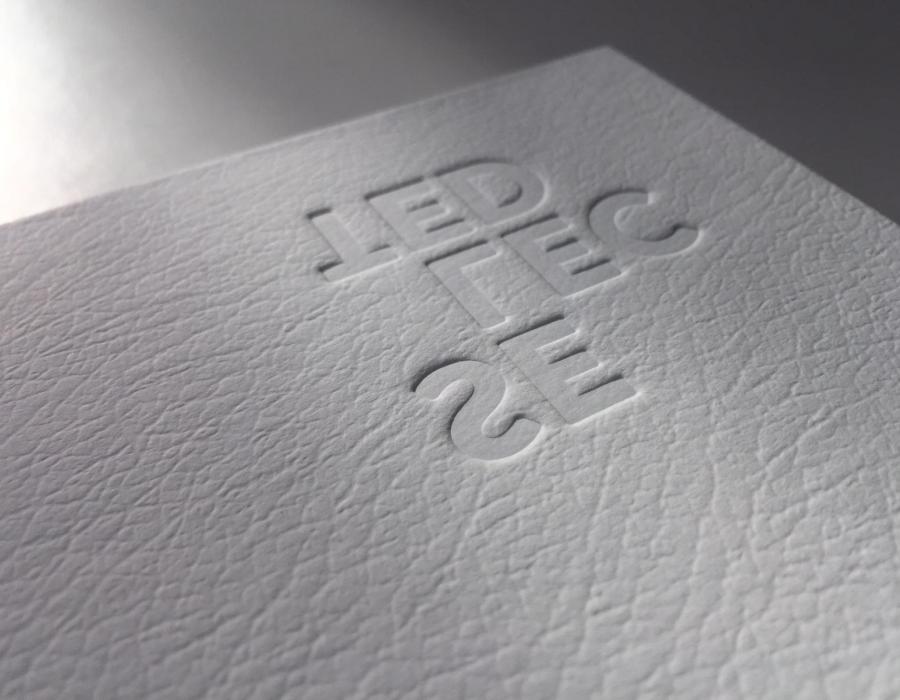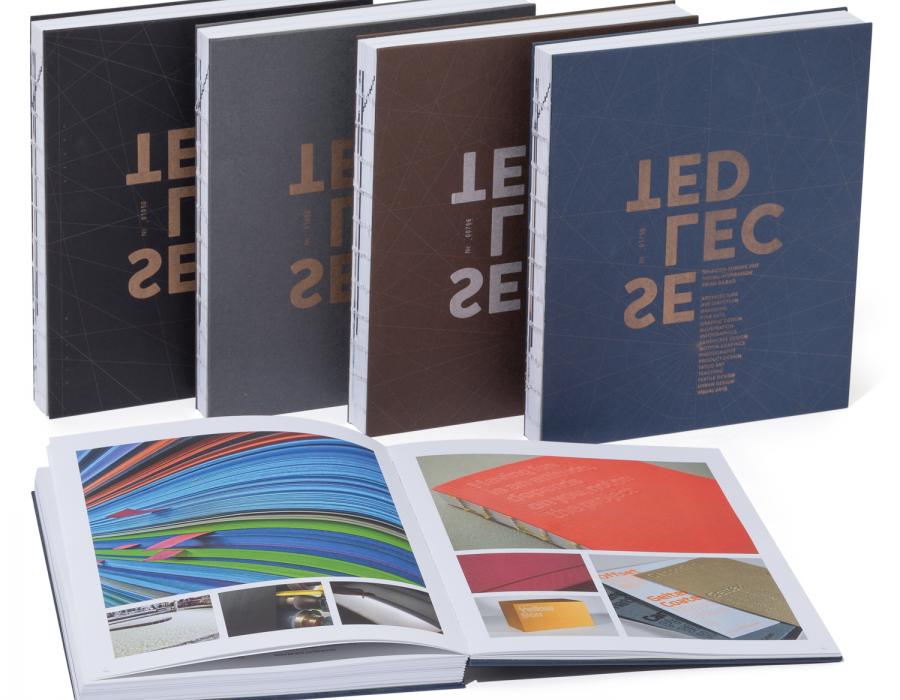
Paper is the star of myriad publishing and packaging projects and copywriters have certain mechanical and aesthetic needs that the producers of this material must be aware of in order to adapt to the existing absolute customisation trends. Therefore, working shoulder to shoulder with designers is indispensable. Otzarreta Think & Make is a creative agency that has worked with Guarro Casas in the publication of the SELECTED book in recent years, a design event targeting this audience. We talked at length about the project and the creative work involving paper with Gabriel Alonso, who works in Otzarreta’s Design department, and Hernán Ordoñez, a designer and lecturer from the FADU – Universidad de Buenos Aires and a lecturer at the IED Barcelona who has also been collaborating with the agency for four years now as Brand Manager.
What kind of projects do you do at Otzarreta?
Gabriel Alonso (G.A): We are a very special enterprise. We started out in the printing production sector (we are getting ever-closer to our 50th anniversary!), although we have gradually reconverted ourselves through design. For this reason, paper plays a very important role for us in production processes. We always try to ground or projects in designing through production in order to deliver that added value that other competitors simply cannot provide. For this reason, the finished result of the project and the pursuit of quality is always essential to us.
Hernán Ordoñez (H.O): The good thing about Otzarreta is that you go to them as a client and the agency gives you a turnkey solution to the problem, from the idea through to the final production.
In what sectors do you work as an agency?
G.A: In recent years, we have operated most in the homewares and furnishings sector, although the company’s reconversion led us to work in many different areas: in five-star restaurants to create the menu, first-division football teams like Real Sociedad, the Guggenheim Museum, with the museum’s itinerary guides… The idea is to work with clients who give us something image-wise and allow us to develop interesting projects, which is why we have diversified a great deal.
How can paper help to convey what a brand or an event is or how is this link established?
H.O: Through sensations that you can transmit with paper that breathe new life into an object, such as a book. When you give someone a tangible item, you are creating a link, a bond, and this connection begins the minute you touch it. Not all materials transmit the same concept to our senses, meaning that you need to make the right choice depending on your brand or event. As I said, we need to give paper a new lease of life, particularly because it often holds the key to your future design decision.
For example, in the case of SELECTED, we want each book to transmit something totally different, which means that the material also needs to change. The third book was far less heavier than the second book, although the volume was the same. But the simple act of picking it up thinking that it will be as heavy as a rock but it turns out to be unexpectedly light already transmitted something. This is why more often than not paper can be even more important than design for a brand.
G.A: Exactly, the object is a tool that can make ideas tangible and create sensations. As many things have gone digital, this part is being lost, particularly the question of sense of touch, although paper gives us the chance to recover this and this is precisely the added value that it provides. This is why paper is used a great deal in premium actions or products.
Besides these aesthetic factors that are involved when you choose a paper, what mechanical factors do you take into account?
H.O: It is always important to think about how the material will respond in production and what type of care needs to be taken when working with a given type of paper. For example, it must be scratch-proof when it comes into contact with other objects. While it is true that the greater the number of mechanical details that need to be considered, the more expensive the final production may be, many projects simply need this. Despite this, and when financial possibilities are more restricted, we do not always need to choose the most delicate material and it will simply suffice to choose a unique but less complex material and create a special item. In this regard, suppliers such as Guarro Casas help us a great deal, because if they do not have the paper that you need they will design it jointly with you and create it.
G.A: In actual fact, sometimes a material can even solve design problems for you. After that, you select a typography that fits in well, then a message, and you have everything you need. It is like any creative process, having a concept is what matters most so that it can be illustrated graphically, etc., in this case on paper.
Otzarreta comes from a printing background. Now that you are a creative agency, do you apply other paper processing techniques?
G.A: Nowadays we do a lot more than just printing. For example, the previous SELECTED book involved no printing whatsoever. We worked with the concept of a blank page, and to convey this we created it in this colour of paper using blind debossing, which worked really well. Now, we use all types of techniques, depending on what we want to transmit: embossing, spot UV, stamping, printing, coloured inks, etc. The important thing is to always adapt to the idea.
H.O: In SELECTED, the objective pursued for the cover every year is to demonstrate the different uses to which paper can be put, and Otzarreta decides this as a design company. The result is that over the last four years, the books have been totally different, and one of the parts that made a difference were the processing techniques used: in the last edition, there was no printing, whereas in the one before that three types of printing were used on the same cover. Last year all the covers were the same, in the one before that all 2,000 were different, they were even numbered. All projects strive to be unique, because if we do one thing one year then we have to do something totally different the following year.
Moreover, we have a production network with Guarro Casas, which always seeks to do things differently, which is exactly why we like working with them. It is all about experimenting. It is true that problems do arise in processing, because when you try to put things into practice this can always happen, although in this case the producer solves it for you. Teamwork is essential.
What are the current trends in graphic design, besides personalisation?
H.O: To begin with, a lot of experiments are being done involving sensations with materials. Paper can simulate an extensive range of surfaces, such as velvet. Although besides all that, books are enjoying a resurgence in terms of value. In the 1990s, hardly anybody had a website, and if you did you were different. Nowadays, nobody has a printed book, so if you do then you are also different. It has become a gift object, and it is one that you will always keep and will maintain that relationship between customer and company.
G.A: Then there are design-related trends. We consume a lot faster than we used to, meaning that we need to display information much more flexibly, such as presenting information or data through infographics. This flexibility also concerns product characteristics: the 300-page book is a thing of the past, books have to be quick and fun, easier to consume. Design must be leveraged to attract users, with special colours and finishes, making them easy to understand, from the cover to the inner content.
H.O: Trends have different threads and this one is highly specific and mega. But then you have specific applications, such as paper in architecture, in ephemeral installations or in performances. Simply by processing this material we can even make rooms, changing the scale. By way of example, the initial prototypes for spaces or venues are made on paper.
Might we say that it is a material that can adapt to many settings or environments?
H.O: Definitely, and moreover it can coexist with the digital world. Paper has a much brighter future than we thought it did 10 years ago. You can have a blog, but then you do the book of the blog and it goes down just as well, and nowadays it is even much easier to sell.
G.A: It is a question of sensations, emotions. In communication, we always say that brands must be emotional, and this can be accomplished through our sense of touch. Evidently, digital products are far easier to consume, but when someone gives you something in a physical format it changes and takes on a life of its own.



